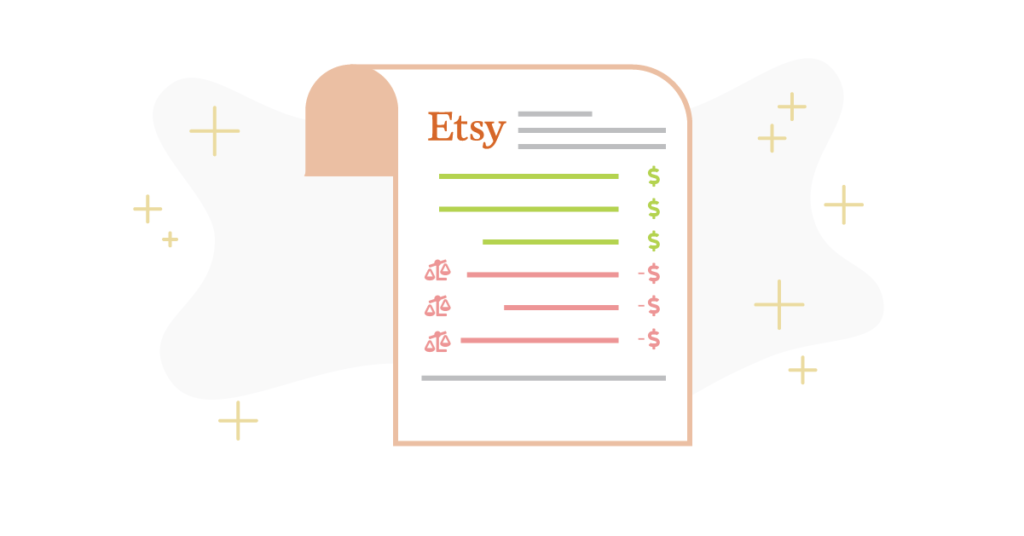One of the reasons why Etsy has become a preferred choice for many sellers is its focus on providing a dedicated platform for handmade and vintage items. Unlike other e-commerce platforms, Etsy caters specifically to sellers who create or curate one-of-a-kind items, giving them a specialized space to showcase their talents and connect with like-minded buyers who appreciate the value of handmade and vintage products.
However, as with any online marketplace, Etsy charges fees for its services, and these fees can impact a seller’s profit margin. It’s important for sellers to understand Etsy’s fee structure and how it can affect their overall profitability. Etsy’s fees include various types, such as listing fees, transaction fees, and payment processing fees. Additionally, Etsy introduced offsite ads, which are advertising campaigns to promote sellers’ products on external platforms, but they also come with fees based on annual revenue.
In this guide, I will explain you How to Understand Etsy Fees and Maximize Your Profit Margin in 2023. Etsy is a bustling online marketplace that has gained immense popularity among artisans, crafters, and vintage enthusiasts alike. Founded in 2005, Etsy has become a go-to platform for sellers to showcase and sell their unique, handcrafted, and vintage items to a global audience of millions of shoppers.
You may also like: Top 10 Must-Know Tips for Making Money on Etsy in 2023
Understand Etsy Fees and Maximize Your Profit Margin
As a seller on Etsy, it’s crucial to be aware of these fees and their impact on your profit margin. Understanding the ins and outs of Etsy’s fee structure is essential for making informed decisions about pricing, expenses, and profit margins to ensure a successful and profitable selling experience on this vibrant online marketplace. In the next sections, we will delve into the details of Etsy’s fee structure and provide tips on how to effectively calculate expenses and set the right profit margin to maximize your earnings on Etsy.
Etsy’s Fee Structure

As a seller on Etsy, it’s crucial to understand the fee structure that comes with selling on this platform. Etsy charges various fees, including listing fees, transaction fees, payment processing fees, and offsite ads fees, which can impact your overall profitability.
1. Listing Fees
When you list an item on Etsy, you may be charged a listing fee, which allows your item to be visible to shoppers. As of the current date, Etsy does not charge a listing fee for each item you list. However, it’s important to keep an eye on Etsy’s fee policy for any updates or changes.
2. Transaction Fees
Etsy charges a transaction fee for each item that is sold on the platform. The transaction fee is calculated based on the total sale price, including shipping costs, and it varies depending on your location. As of the current date, US sellers are charged a transaction fee of 3% of the total sale price, plus a flat fee of $0.25 per order. It’s important to note that transaction fees are only applicable when you make a sale.
3. Payment Processing Fees
If you use Etsy Payments (previously known as Etsy Direct Checkout) to process payments from buyers, Etsy charges a payment processing fee for each transaction. The payment processing fee is calculated based on a percentage of the total sale price, and it varies depending on your location. As of the current date, US sellers are charged a payment processing fee of 3% of the total sale price, plus a flat fee of $0.25 per order. It’s important to keep in mind that payment processing fees are separate from transaction fees and are charged on top of them.
4. Offsite Ads Fees
Etsy introduced offsite ads as a way to promote sellers’ products on external platforms. If your shop is enrolled in Etsy’s offsite ads program, you may incur additional fees when you make a sale through these ads. The offsite ads fee is calculated based on a percentage of the order total and varies depending on your annual revenue. As of the current date, if you made less than $10,000 on Etsy in the past 365 days, you’ll be charged a 15% fee on the order total. If you made at least $10,000, you’ll get a discounted fee of 12%. It’s important to note that the offsite ads fee will never exceed $100 for an order, regardless of the order total.
It’s essential for sellers to carefully consider these fees when pricing their products and calculating their expenses. Understanding the different types of fees and their associated costs is crucial for setting the right profit margin and maximizing earnings on Etsy. It’s also important to regularly review Etsy’s fee policy for any updates or changes to ensure that you are accurately accounting for all the fees associated with selling on the platform. By being aware of Etsy’s fee structure and factoring it into your pricing and financial calculations, you can effectively manage your expenses and optimize your profit margin on this popular online marketplace.
Calculating Expenses

As an Etsy seller, it’s important to have a clear understanding of the various fees associated with selling on the platform. These fees can impact your overall profit margin and affect your business’s financial success. Let’s break down the different expenses you should consider when selling on Etsy and how they can add up.
Listing Fees
When you create a listing on Etsy, you may be charged a listing fee. As of the current information available, Etsy does not charge a listing fee for the first 4 months, but after that, a $0.20 listing fee is charged for each item listed for sale on the platform. This fee is charged regardless of whether your item sells or not, so it’s important to factor it into your overall expenses.
Transaction Fees
Etsy charges a transaction fee on each item sold on the platform. The percentage and flat fee vary depending on where your business is located. For sellers in the United States, the current transaction fee is 5% of the total sale price, plus a $0.25 flat fee per order. It’s essential to keep in mind that this fee is calculated based on the total sale price, including shipping costs, and can add up quickly, especially for higher-priced items.
Payment Processing Fees
Etsy also charges a payment processing fee for each sale made through Etsy Payments, which was previously known as “Etsy Direct Checkout.” The payment processing fee is calculated as a percentage of the total sale price, and an additional flat fee per order may apply as well. The percentage and flat fee vary depending on your business location. It’s important to factor in these fees when pricing your items to ensure you’re not losing money on payment processing.
Offsite Ad Fees
Etsy introduced Offsite Ads, which allow your listings to be promoted on external platforms. However, if your shop made sales of less than $10,000 on Etsy in the past 365 days, you’ll be charged a 15% fee on the order total for each sale made through Offsite Ads. If your shop made at least $10,000, you’ll get a discounted fee of 12%. It’s important to note that the Offsite Ad fee will never exceed $100 for an order, regardless of the order total.
All these fees can add up quickly and impact your profit margin. Let’s look at an example to better understand the expenses associated with selling on Etsy:
Example Let’s say you sell handmade jewelry on Etsy and you list an item for $50, with $5 shipping. Here’s how the fees would be calculated:
- Listing fee: $0.20
- Transaction fee: 5% of $50 = $2.50 + $0.25 flat fee = $2.75
- Payment processing fee: 3% of $55 (total sale price + shipping) = $1.65 + $0.25 flat fee = $1.90
- Offsite Ad fee: 15% of $55 (total sale price + shipping) = $8.25
Total fees: $0.20 + $2.75 + $1.90 + $8.25 = $13.10
Setting the Right Profit Margin

As an Etsy seller, setting the right profit margin is crucial to ensure profitability and success in your online business. Profit margin is the percentage of revenue that remains as profit after deducting all expenses. It is an important financial metric that reflects the effectiveness of your pricing strategy and business operations.
Calculating your profit margin involves considering your expenses and desired profit. Here are some tips on how sellers can calculate their profit margin effectively:
Identify all expenses
Sellers should carefully consider all the expenses associated with selling on Etsy. This includes listing fees, transaction fees, payment processing fees, and offsite ad fees, among others. It’s important to keep track of all these expenses and factor them into your profit margin calculation.
Calculate cost of goods sold (COGS)
COGS refers to the direct costs associated with producing or purchasing the products you sell on Etsy. This includes the cost of materials, labor, and any other direct costs incurred in creating your products. Calculating COGS accurately is essential to determine your gross profit margin.
Determine desired profit margin
Sellers should also decide on their desired profit margin, which is the percentage of profit they want to make on each sale. This can vary depending on your business goals and financial objectives.
Once you have the necessary data, you can use the following formula to calculate your profit margin: Profit Margin = (Total Revenue – COGS – Expenses) / Total Revenue * 100
It’s important to regularly review and update your profit margin to ensure it aligns with your business goals and remains competitive in the market.
Factors to Consider when Setting Profit Margin:
- Market competition: It’s crucial to research and analyze the pricing strategies of your competitors on Etsy. Consider the prices of similar products and services to ensure your profit margin is competitive enough to attract customers while still covering your expenses and desired profit.
- Target audience: Understanding your target audience and their purchasing power is essential in setting the right profit margin. Consider the price sensitivity of your target audience and adjust your profit margin accordingly to appeal to their preferences and purchasing behavior.
- Item uniqueness: If you offer unique and one-of-a-kind products on Etsy, you may have more flexibility in setting a higher profit margin. Consider the exclusivity and rarity of your products when determining your profit margin.
Setting the right profit margin is crucial for Etsy sellers to ensure profitability and long-term success. By accurately calculating expenses, considering desired profit, and factoring in market competition, target audience, and item uniqueness, sellers can establish a pricing strategy that maximizes their profits while remaining competitive in the online marketplace. Regularly reviewing and updating your profit margin can help you make informed pricing decisions and achieve your business objectives.
Maximizing Profit Margin on Etsy

As an Etsy seller, maximizing your profit margin is crucial to ensure profitability and success. By implementing practical strategies, you can increase your revenue and reduce your expenses, ultimately maximizing your profit margin. Here are some effective strategies to consider:
Optimize Listings to Improve Search Rankings
Search rankings on Etsy can greatly impact your visibility to potential customers. By optimizing your product listings with relevant keywords, clear descriptions, and high-quality images, you can improve your search rankings and attract more customers.
Choose the Right Payment Processing Options
Carefully consider the payment processing options available on Etsy and choose the one that offers the best rates and fees for your business. Compare different options and negotiate fees if possible to reduce your transaction costs and increase your profit margin.
Manage Offsite Ad Costs
Etsy offers offsite advertising options to promote your products, but these can come with additional costs. Keep a close eye on your offsite ad costs and evaluate their effectiveness in driving sales. Adjust your budget and advertising strategies accordingly to ensure you are getting the best return on investment (ROI) and maximizing your profit margin.
Set Competitive Prices
Pricing your products competitively is crucial to attract customers and generate sales. Research the market and set prices that are competitive, yet profitable. Consider factors such as material costs, labor, and overheads when determining your prices to ensure you are covering all expenses while still setting prices that are appealing to customers.
Offer Promotions
Offering promotions, such as discounts, bundle deals, or free shipping, can attract customers and boost sales. Be strategic in offering promotions that still allow you to maintain a healthy profit margin. Consider the impact of promotions on your expenses and revenue to ensure they are beneficial to your overall profitability.
Provide Excellent Customer Service
Providing exceptional customer service can lead to repeat business, positive reviews, and word-of-mouth referrals. Happy and satisfied customers are more likely to become loyal customers, resulting in increased sales and repeat purchases. Focus on building customer relationships and providing excellent customer service to retain customers and increase your revenue.
Maximizing your profit margin on Etsy requires a strategic approach. By optimizing your expenses, pricing competitively, offering promotions, and providing excellent customer service, you can increase your revenue and reduce your expenses, ultimately maximizing your profit margin and ensuring profitability on Etsy.
Conclusion
In conclusion, this blog post has discussed practical strategies for sellers to maximize their profit margin on Etsy. By carefully considering Etsy’s fee structure and calculating their expenses, sellers can set the right profit margin and ensure they are pricing their products effectively. Additionally, optimizing listings to improve search rankings, choosing the right payment processing options, and managing offsite ad costs are effective ways to reduce expenses and increase profitability. Moreover, setting competitive prices, offering promotions, and providing excellent customer service are proven strategies to boost revenue and increase overall profitability.
As a closing statement, it is important for Etsy sellers to take a proactive approach in implementing these strategies in their business. By carefully managing expenses and optimizing revenue, sellers can maximize their profit margin and achieve financial success on Etsy. So, go ahead and start implementing these strategies in your Etsy shop today and watch your profit margin soar! Best of luck on your journey to success on Etsy!



